Are you someone who loves to go fishing but is frustrated with your rusty fishing reel? If so, you’ve come to the right place. In this guide, we will walk you through the steps on how to remove rust from fishing reel.
Rust can be the arch-nemesis of any fishing enthusiast, turning a prized reel into a stiff, underperforming piece of gear. Fortunately, with some elbow grease and the right approach, removing rust and restoring your fishing reel to its former glory is possible. This guide will walk you through the necessary steps to effectively tackle rust using everyday household items and some specialized products.

Whether your reel has just started showing signs of rust or has been battling corrosion for some time, these tips will help you get back to smooth casting and reeling quickly.
Why Do Fishing Reels Rust?
Before we dive into removing rust from your fishing reel, it’s essential to understand why rust occurs in the first place. Fishing reels are constantly exposed to water containing oxygen and minerals that can cause metal components to corrode and form rust.
Rust is essentially iron oxide, a byproduct of the oxidation process when metal comes into contact with oxygen and moisture. In addition to causing unsightly orange stains on your reel, rust can also weaken the metal and cause it to become brittle over time.
Tools and Materials You Will Need
You will need a few basic tools and materials to remove rust from your fishing reel effectively. These include:
- White Vinegar: This common household item is a mild acid that removes rust.
- A Toothbrush or Small Wire Brush: These tools will help you scrub away rust from hard-to-reach areas.
- Fine-grit Sandpaper: This can gently sand down any rough, rusty spots on your reel.
- Steel Wool or a Scouring Pad: Steel wool or a scouring pad can help remove tougher rust stains effectively.
- A Sponge or Cloth: These will be used to apply and wipe away the cleaning solution.
- Metal Polish: This can help restore shine and protect your reel from future rusting.
Now that you have gathered all the necessary tools and materials, here are the steps you should follow to remove rust from your fishing reel
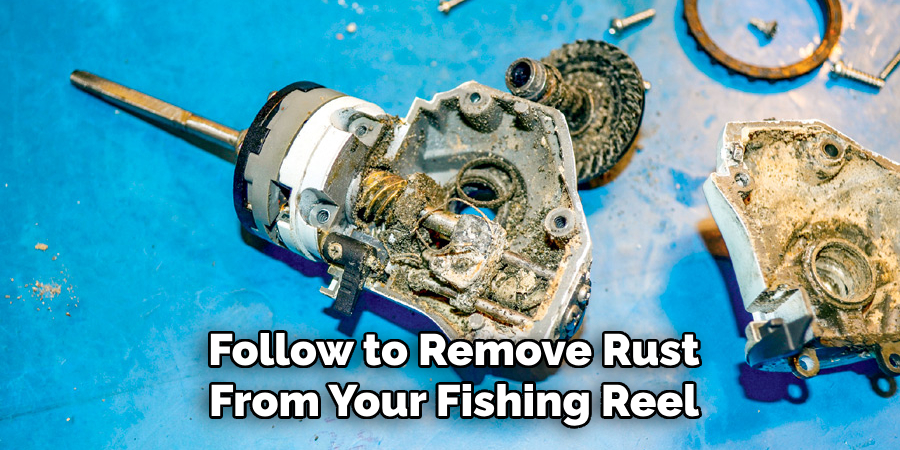
10 Easy Steps on How to Remove Rust From Fishing Reel
Step 1. Disassemble Your Fishing Reel Carefully:
Begin by taking apart your fishing reel. This step is crucial as it allows you to access and meticulously clean every component. Ensure you keep track of all the parts and how they fit together to avoid any reassembly issues later on.
Step 2. Submerge the Rusty Parts in White Vinegar:
Once you’ve disassembled your reel and identified the rust-affected parts, place them in a container filled with white vinegar. Ensure that the parts are completely submerged. White vinegar is a practical, non-toxic rust remover due to its mild acidity. Allow the parts to soak for at least 24 hours.
This soaking period gives the vinegar ample time to break down the rust. Depending on the severity of the rust, you may need to leave the parts in vinegar for longer. During this time, the acid in the vinegar reacts with the rust (iron oxide), helping to dissolve the bond between the rust and the metal. This step is gentle on the metal and effectively tackles even tough rust without resorting to harsh chemicals.
Step 3. Scrub the Parts with a Brush or Steel Wool:
After soaking, take the parts out of the vinegar and use a toothbrush, small wire brush, or steel wool to scrub the rust off. You’ll notice the rust will come off more quickly after the soak. Be sure to scrub gently to avoid damaging any of the metal surfaces. For tougher rust stains or spots, apply more pressure or use steel wool for a more abrasive action. This step helps remove the loosened rust particles and clears the way for a more thorough cleaning.
Step 4. Rinse the Parts with Clean Water:
Once you have scrubbed away as much rust as possible, rinse each part thoroughly with clean water. This step is essential for removing any remaining vinegar and loosened rust particles. It’s crucial to ensure no vinegar residue is left on the parts, as this could lead to further corrosion if not properly rinsed off. After rinsing, dry all the parts with a soft cloth or towel to prevent new rust from forming due to leftover moisture.
Step 5. Sand Any Remaining Rust Spots:
If, after scrubbing, you find that some rust spots or stains persist, gently sand these areas with fine grit sandpaper. This step requires a delicate touch to avoid scratching or damaging the metal surface. Focus on the rusted areas, applying enough pressure to remove the rust without compromising the integrity of the reel’s parts. Sanding is particularly useful for smoothing out rough textures left by rust, ensuring that your reel operates smoothly. After sanding, clean the parts to remove any dust or debris before moving on to the next step.
Step 6. Apply Metal Polish to Restore Shine:
Once all the rust has been removed and the parts have been cleaned, apply a small amount of metal polish to each component. Use a soft cloth or sponge to rub the polish into the metal, following the manufacturer’s instructions. Metal polish not only restores the shine of your fishing reel but also provides a protective layer that can help prevent future rusting. After applying the polish, buff the parts gently to bring out a brilliant shine, ensuring that your reel works like new and looks the part, too.
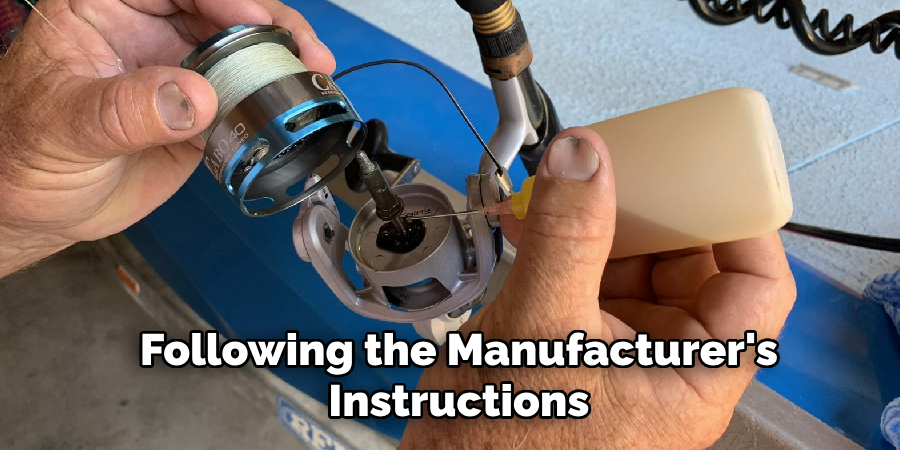
Step 7. Reassemble Your Fishing Reel Carefully:
Now that your fishing reel’s parts are clean, rust-free, and polished, it’s time to put everything back together. Start by organizing all the components on a clean, flat surface according to the order they need to be reassembled. Follow the assembly instructions carefully, ensuring each part is correctly positioned and securely fastened. Reassembling your reel accurately is crucial for its optimal performance. If you encounter any difficulties, consult the reel’s manual or seek advice from a professional. Once reassembled, give your reel a final inspection to ensure everything moves smoothly and is properly in place.
Step 8. Test Your Fishing Reel:
After reassembling your fishing reel, testing it to ensure it operates smoothly and efficiently is essential. Attach the reel to your fishing rod, thread the line, and practice casting. Pay attention to the reel’s action, ensuring no stiffness or catching. The moving parts should operate seamlessly, reflecting the thorough cleaning and maintenance. If you notice any issues, it may be necessary to disassemble and check the parts for correct placement or further cleaning. This step is crucial for confirming that your reel is in optimal condition for your next fishing adventure.
Step 9. Lubricate the Reel:
After testing your fishing reel and ensuring that all parts are correctly assembled and functioning smoothly, the next step is to lubricate the reel. Use a high-quality lubricant explicitly designed for fishing reels to oil the moving parts. Apply the lubricant sparingly to gears, bearings, and any other parts where metal contacts metal. This step is crucial for reducing friction, ensuring smooth operation, and prolonging the life of your reel. Proper lubrication also helps prevent rust and corrosion, keeping your reel in good condition for future fishing trips. After applying the lubricant, rotate the reel several times to distribute the oil evenly.
Step 10. Store Your Fishing Reel Properly:
After you’ve completed the maintenance, including cleaning, polishing, and lubricating your fishing reel, storing it properly to ensure its longevity is essential. Choose a dry, cool place away from direct sunlight and moisture, as these elements can contribute to rust and corrosion over time. Hang the reel or place it on a reel rack to avoid any unnecessary pressure on its components. Covering the reel with a soft cloth or in a protective bag can also prevent dust accumulation and accidental damage. Remember to loosen the drag before storage to relieve tension on the reel’s internal mechanisms. Proper storage will keep your fishing reel in optimal condition, ready for your next fishing adventure.
Following these steps, you can effectively remove rust from your fishing reel and restore it to its former glory. Regular maintenance is key in preventing rust from damaging your reel and ensuring it operates efficiently for years.
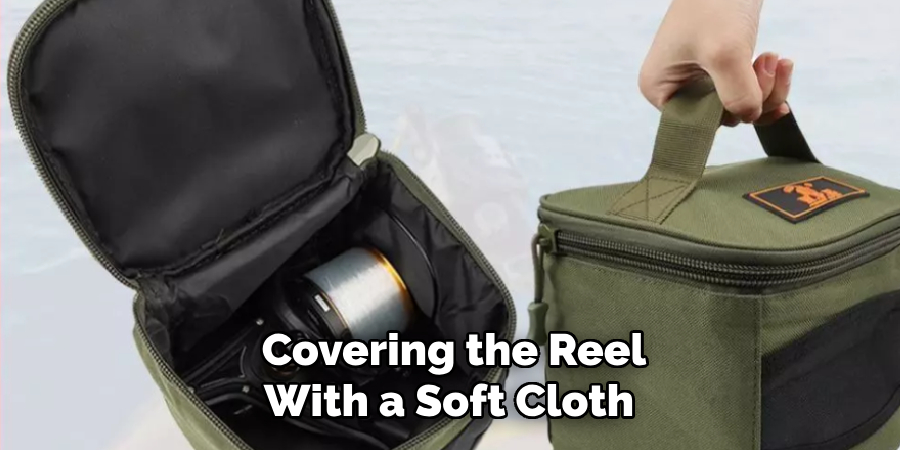
5 Additional Tips and Tricks
- Use Lemon Juice and Salt Mixture: For a natural rust removal solution, mix lemon juice and salt in equal parts to create a paste. Apply the paste to the rusted areas of the reel and allow it to sit for a few hours. The acid in the lemon juice will help break down the rust, while the salt acts as a mild abrasive. After letting it sit, scrub gently with a soft brush and rinse thoroughly.
- Preventive Coatings: After cleaning your reel, consider applying a thin layer of silicone-based lubricant or a rust inhibitor specifically designed for metal parts. These products form a protective barrier that minimizes moisture exposure and prevents rust formation.
- Utilize Aluminum Foil for Scrubbing: An unconventional yet effective method for removing rust involves aluminum foil. Dip a piece of aluminum foil in water or vinegar and gently scrub the affected areas. The chemical reaction between aluminum and rust, facilitated by the liquid, helps loosen and lift rust without scratching the reel’s surface.
- WD-40 for Stubborn Rust Spots: For difficult-to-remove rust spots, spray a small amount of WD-40 directly onto the affected areas. Allow it to sit briefly before gently scrubbing and wiping clean. Be sure to rinse and dry the reel afterward thoroughly.
- Regular Cleaning and Maintenance: Regular cleaning and maintenance are crucial in preventing rust formation and keeping your fishing reel in top condition. After each use, rinse your reel with fresh water and dry it thoroughly to remove any saltwater or debris that may promote rust. Additionally, check for any signs of wear or damage and address them promptly before they escalate into more significant issues.
With proper care and maintenance, your fishing reel can last a lifetime and provide many memorable fishing trips.
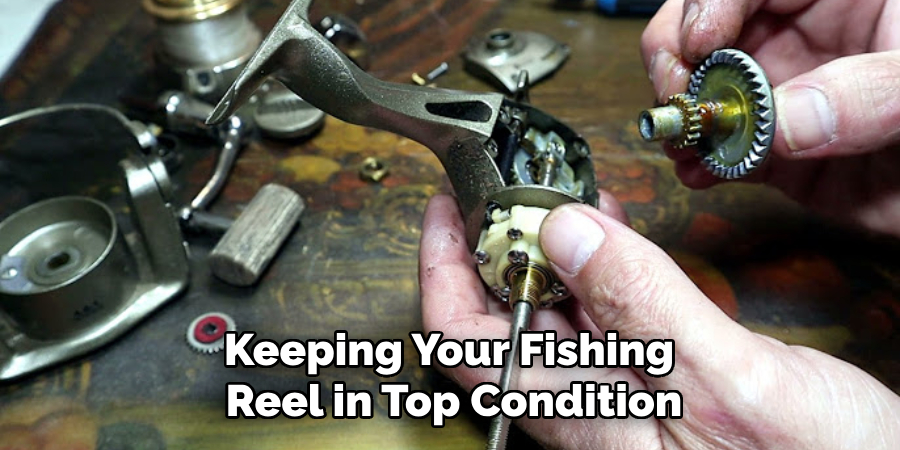
5 Things You Should Avoid When Removing Rust from Your Fishing Reel
- Using Harsh Chemicals: Steer clear of harsh or corrosive chemicals for rust removal. Such substances can damage not only the reel’s surface but also compromise the integrity of its parts. Stick to milder solutions specifically designed for fishing reels or natural alternatives.
- Overlooking Protective Gear: Always wear gloves and protective eyewear when handling rust removal products or performing any cleaning and maintenance on your fishing reel. This protects your skin and eyes from potential irritants found in cleaning agents.
- Scrubbing Aggressively with Abrasive Tools: Avoid using steel wool or any overly abrasive scrubbing tools that can scratch or further damage the reel’s surface. Opt for softer brushes or cloths that effectively remove rust without harming the reel.
- Ignoring Manufacturer’s Instructions: It’s vital to adhere to the manufacturer’s guidelines when disassembling, cleaning, and reassembling your reel. Each model may have specific care instructions, ignoring which could result in damage or improper functioning of the reel.
- Neglecting Timely Maintenance: Do not wait for rust to appear before you start caring for your reel. Regular maintenance is the key to preventing rust and ensuring your reel remains in prime condition. Avoid exposing your reel to environments that accelerate rust formation, such as leaving it damp or storing it in moist conditions.
By avoiding these common pitfalls, you can ensure your fishing reel remains rust-free and maintains its performance and longevity.
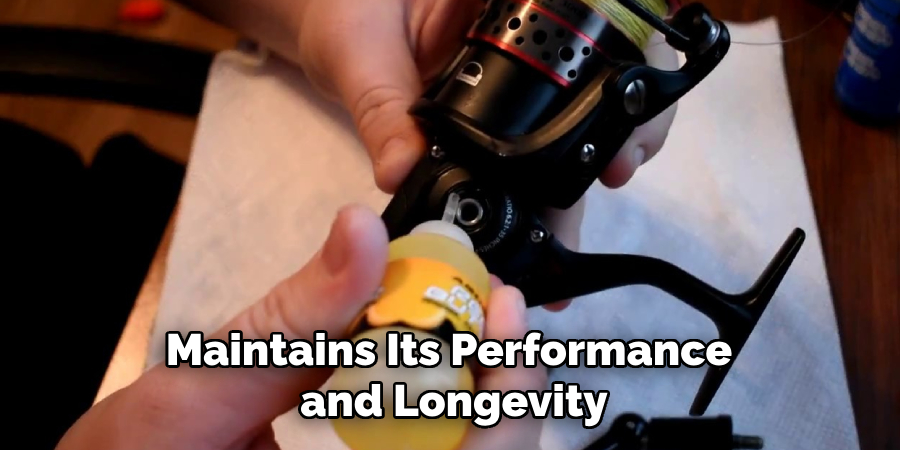
5 Different Types of Lubricants for Fishing Reels
- Reel Oil: This is a thin, lightweight oil formulated explicitly for fishing reels. It penetrates excellently and effectively lubricates all parts, including bearings, gears, and moving components.
- Grease: Grease is thicker and more viscous than reel oil, making it suitable for heavy-duty applications. It’s ideal for greasing more giant gears, such as those found in baitcasting reels, and can withstand continuous use without frequent reapplication.
- Silicone-based Lubricants: Silicone-based lubricants are versatile and effective in preventing rust formation on fishing reels. They create a protective layer that repels moisture and reduces friction while remaining compatible with most materials.
- Dry Lubricants: Dry lubricants, such as graphite or molybdenum disulfide, come in powder form and provide a thin layer of lubrication that minimizes friction without attracting dirt or debris. They are suitable for use on small parts and delicate components.
- Teflon Lubricants: Teflon lubricants are known for their slick, non-stick properties and can effectively reduce friction and wear on fishing reel parts. They are also water-resistant, making them ideal for use in saltwater environments.
It’s important to choose the right type of lubricant for your specific reel model and usage to ensure optimal performance and protection against rust.
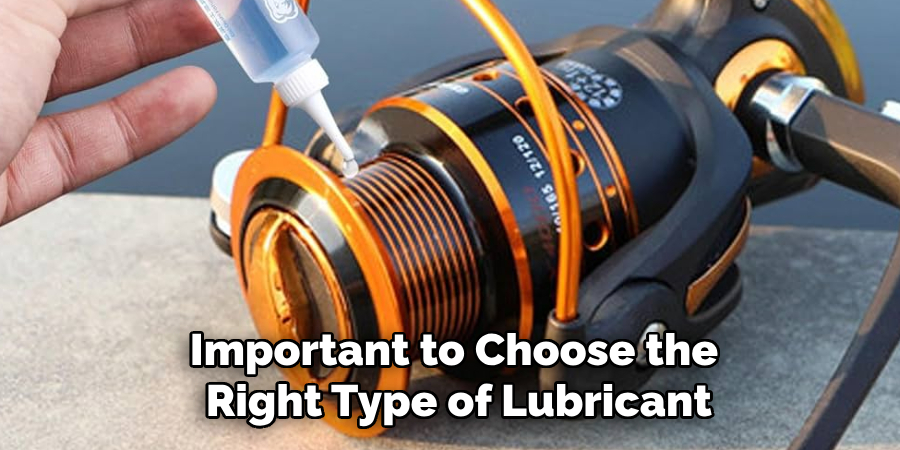
Does Toothpaste Remove Rust?
It is a common belief that toothpaste can be used as a rust removal agent due to its mild abrasive nature. While it may work for small, surface-level rust spots, it is not recommended as a reliable method for removing extensive rust from your fishing reel.
Toothpaste does not have the chemical properties to dissolve and break down rust effectively, making it less effective than other proven methods. Sticking to using specialized products or natural alternatives for rust removal from your fishing reel is best.
Overall, prevention is critical in keeping your fishing reel rust-free. With regular maintenance, proper storage, and timely cleaning, you can enjoy a smooth and hassle-free fishing experience for years.
How Do You Permanently Remove Rust?
While there is no foolproof method for permanently removing rust, regular maintenance, and proper care can significantly reduce its likelihood of occurring. However, if your reel has extensive rust buildup, the best action would be to disassemble it and thoroughly clean each part with a rust removal solution. You may also need specialized tools or techniques to remove stubborn rust spots.
After cleaning, apply a protective coating or lubricant to prevent future rust formation. Store your reel in a dry place and avoid exposure to moisture. Regularly check and clean your reel for any signs of rust and address them promptly.
By following these steps, you can effectively remove rust from your fishing reel and prolong its lifespan.

Conclusion
In conclusion, proper care and maintenance are crucial for keeping your fishing reel in optimal condition. Avoiding harsh chemicals, using protective gear, not scrubbing aggressively with abrasive tools, following the manufacturer’s instructions, and regularly maintaining your reel are essential to prevent rust formation.
When choosing a lubricant for your reel, consider the type of reel you have and its intended usage. While toothpaste may work for minor rust spots, it is not recommended as a permanent solution. Instead, opt for specialized products or natural alternatives.
Hopefully, the article on how to remove rust from fishing reel and the different types of lubricants for fishing reels has provided you with valuable insights on how to care for your reel and prevent rust formation properly. Happy fishing!
About the Author
Jennifer Branett is the author of Fishy Kayak and an expert in fish-related fields, with over 10 years of experience. Her work blends passion for fishing with a commitment to conservation.
Educational Background
Degree: Bachelor’s in Marine Biology
Institution: University of California, Santa Barbara
Specializations: Aquatic ecosystems, fish behavior, and sustainable practices
Professional Experience
Conservation Projects:
Collaborated with local organizations to restore aquatic habitats
Developed educational programs on sustainable fishing practices
Publications:
Authored articles for fishing magazines and environmental journals
Featured speaker at fishing expos and conservation conferences
Key Areas of Expertise
Fishing Techniques:
Kayak fishing strategies
Freshwater and saltwater fishing methods
Environmental Stewardship:
Advocacy for sustainable fishing
Promoting biodiversity in aquatic environments
Awards and Recognition
Recipient of the [Specific Award Name] for contributions to marine conservation
Recognized as a leading voice in the fishing community by [Organization/Publication Name]
Community Engagement
Workshops and Seminars:
Regularly hosts events to educate anglers on sustainable practices
Engages with youth programs to inspire the next generation of fishers
Online Presence:
Maintains an active blog sharing tips, stories, and conservation efforts
Engages with followers on social media to promote fishing ethics
Personal Interests
Enjoys kayaking in scenic locations
Passionate about photography, capturing the beauty of nature
Advocates for local conservation efforts in her community
